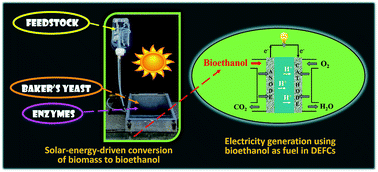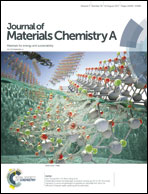Solar-energy-driven conversion of biomass to bioethanol: a sustainable approach
Abstract
Bioethanol is one of the most promising transportation fuels with economic, environmental, and energy benefits. However, currently, the production methodologies and purification technologies of the biofuel industry are not economical. This review demonstrates an economically viable, energy efficient, and sustainable alternative to the state-of-the-art process for bioethanol production from biomass. We have developed a solar-thermal-energy-driven simultaneous saccharification and fermentation (SSF) process for single-step conversion of biomass to bioethanol. In the early stages, aqueous solutions of glucose, starch, or cellulose were fed into a specially designed solar reactor containing instant baker's yeast (Saccharomyces cerevisiae) and the necessary enzymes. The yeast (biocatalyst) was not supplemented by any other nutrient, and it was demonstrated that the same yeast and enzymes could be used for at least two months without any decrease in enzymatic activity. After obtaining very high yields (up to 91% of the theoretical yield) and excellent separation of ethanol from the fermentation broth, the methodology was successfully extended to a continuous-flow single-step conversion of marine algae Ulva rigida to bioethanol (84% of the theoretical yield). Harnessing solar thermal energy for driving the SSF reaction as well as the special design of the solar reactor that facilitates in situ separation of ethanol from the fermentation broth by an evaporation–condensation process make the current method industrially appealing and adoptable for large-scale production. This review explores new avenues for a decentralized power supply based on solar thermal energy. The bioethanol produced in this study was demonstrated as a potential fuel for direct ethanol fuel cells with high current and power density values, and 65% thermodynamic efficiency. In addition, the secondary metabolite glycerol was fully reduced to the value-added product 1,3-propanediol by S. cerevisiae, which is the first example of a fungal strain converting glycerol in situ to 1,3-propanediol. In this review, we aim to discuss the current methodologies and recent developments for bioethanol production from biomass and demonstrate the future aspects of bioethanol production in solar reactors, and strategies to improve process yields as well as the prospects of using a solar reactor to produce other valuable chemicals.

- This article is part of the themed collection: Recent Review Articles


 Please wait while we load your content...
Please wait while we load your content...